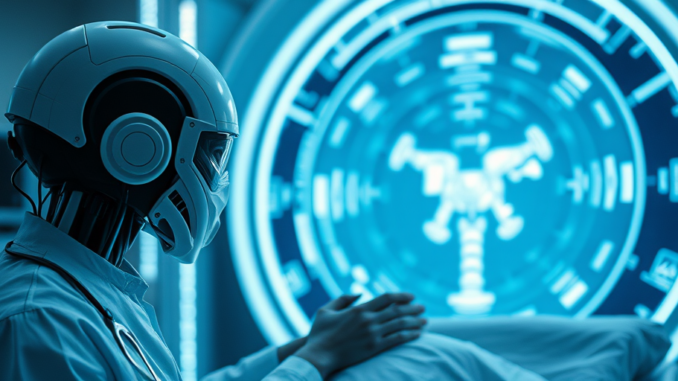
Summary
AI is transforming radiology, enhancing diagnostic accuracy, optimizing workflows, and improving patient outcomes. From image analysis and diagnostics to personalized treatment plans and remote care, AI is poised to reshape medical practices and improve healthcare accessibility worldwide. This article delves into the current and future applications of AI in radiology, highlighting its potential to revolutionize the field and ultimately benefit patients.
Main Story
Artificial intelligence, or AI, is making serious waves in healthcare, and radiology, well, it’s right there at the forefront of all this change. You see, AI’s ability to crunch through complex medical images, automate the humdrum tasks, and, frankly, pull real insights from mountains of data is setting the stage for a total rethink of how medicine is practiced. It’s all about better diagnoses, more efficient workflows and, ultimately, improved results for patients.
Boosting Accuracy and Speed, That’s the Name of the Game
One of the biggest wins with AI is its impact on diagnostic accuracy and efficiency. I mean, these AI algorithms can analyze X-rays, CT scans, MRIs, you name it, at speeds and with a precision that’s honestly kind of mind-blowing. They can even spot the super subtle stuff, tiny anomalies that a human eye might miss, which, of course, leads to earlier, more accurate diagnoses. This is a really big deal when we’re talking about conditions like cancer, where early detection can be a total game changer.
Also, AI can automate the tedious stuff, like image processing and analysis. This frees up radiologists to focus on complex cases and actually engage with their patients more, which is good for everyone. Plus, AI can standardize how images are interpreted, minimizing variations between different radiologists and leading to more consistent diagnoses. Remember that time I had to send a scan for a second opinion, and the interpretations were totally different? AI could definitely solve that.
Better Patient Outcomes and More Access to Care
AI has the potential to dramatically improve patient outcomes, no question. By analyzing a person’s data—medical history, images, even genetic stuff—AI can help tailor treatment plans. This means identifying the best approaches for each individual, potentially leading to better responses, fewer side effects, and happier patients.
Further, AI-powered telemedicine and remote imaging solutions are democratizing access to diagnostic services. Patients in remote areas can get expert advice and imaging without a big trek. It’s taking down those geographical barriers and improving healthcare around the world. Which is pretty cool, right?
The Future’s Looking Bright, But What About the Radiologists?
The future of AI in radiology is pretty exciting. AI is already speeding up research by automating data analysis and finding new insights from huge datasets; this is going to push the boundaries of medicine. Some people are worried that AI will replace radiologists. That’s just not the case. AI is a powerful tool, sure, but it’s more about enhancing their work. Radiologists will, increasingly, be the ones bringing all the information together, using the insights from AI to make the best decisions for their patients. Their job might evolve to include more clinical interaction with patients, and consulting with other doctors, as they help interpret the AI’s findings.
Challenges, Yeah, We’ve Got Those Too
Despite all the positives, there are some challenges to tackle. We’ve got to make sure patient data is kept private and secure, which is paramount, given that AI relies on all this data to work its magic. The accuracy and reliability of AI algorithms have to be validated to ensure patient safety and prevent misdiagnosis, too. That’s non-negotiable.
Also, we need to address the potential for bias in AI. If the data these algorithms are trained on reflects existing biases, the algorithms might actually worsen them, and that could create disparities in healthcare. We must continuously research and improve to ensure a responsible and ethical rollout of AI in radiology.
Final Thoughts
AI is transforming radiology at a breakneck pace. It’s opening doors for increased accuracy, better workflows, and, ultimately, improved patient care. From image analysis to personalized plans to remote care, AI is making big waves. As the tech keeps evolving, its role in radiology will only grow, and that’s going to benefit both patients and healthcare professionals. At the end of the day, the collaboration between humans and machines will be what allows us to truly make the most of AI in healthcare. And isn’t that, really, what it’s all about?


So, you’re suggesting AI is some kind of radiology superhero? Are we just ignoring the potential for robot overlords misdiagnosing us all or is that just my overactive imagination again?
That’s a great point! While ‘superhero’ might be a bit strong, the increased accuracy and efficiency AI brings is definitely impressive. We need to stay vigilant about data security and prevent bias to ensure we’re using these tools responsibly, but the potential is immense.
Editor: MedTechNews.Uk
Thank you to our Sponsor Esdebe – https://esdebe.com
Given AI’s potential for personalized treatment plans, what considerations are being made to ensure equitable access and avoid exacerbating existing healthcare disparities?
That’s a really important question! Addressing equitable access is crucial as we integrate AI into healthcare. We need to focus on diverse data sets and actively work to mitigate any biases in algorithms to ensure that everyone benefits from these advancements.
Editor: MedTechNews.Uk
Thank you to our Sponsor Esdebe – https://esdebe.com
The point about AI standardizing image interpretation is significant; it could greatly reduce diagnostic variability between different practitioners.
That’s a really good observation! Standardizing image interpretation has huge potential. It not only reduces variability, but could also lead to faster and more consistent diagnoses across different healthcare settings, improving patient care.
Editor: MedTechNews.Uk
Thank you to our Sponsor Esdebe – https://esdebe.com